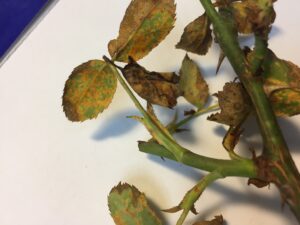Pest Alert – Rust on Roses
go.ncsu.edu/readext?802441
en Español / em Português
El inglés es el idioma de control de esta página. En la medida en que haya algún conflicto entre la traducción al inglés y la traducción, el inglés prevalece.
Al hacer clic en el enlace de traducción se activa un servicio de traducción gratuito para convertir la página al español. Al igual que con cualquier traducción por Internet, la conversión no es sensible al contexto y puede que no traduzca el texto en su significado original. NC State Extension no garantiza la exactitud del texto traducido. Por favor, tenga en cuenta que algunas aplicaciones y/o servicios pueden no funcionar como se espera cuando se traducen.
Português
Inglês é o idioma de controle desta página. Na medida que haja algum conflito entre o texto original em Inglês e a tradução, o Inglês prevalece.
Ao clicar no link de tradução, um serviço gratuito de tradução será ativado para converter a página para o Português. Como em qualquer tradução pela internet, a conversão não é sensivel ao contexto e pode não ocorrer a tradução para o significado orginal. O serviço de Extensão da Carolina do Norte (NC State Extension) não garante a exatidão do texto traduzido. Por favor, observe que algumas funções ou serviços podem não funcionar como esperado após a tradução.
English
English is the controlling language of this page. To the extent there is any conflict between the English text and the translation, English controls.
Clicking on the translation link activates a free translation service to convert the page to Spanish. As with any Internet translation, the conversion is not context-sensitive and may not translate the text to its original meaning. NC State Extension does not guarantee the accuracy of the translated text. Please note that some applications and/or services may not function as expected when translated.
Collapse ▲Rose rust disease has been showing up on ‘knock out’ roses lately. This fungus is a common infection in roses. Rose rust is a disease that causes orange-colored spots to appear on the leaves and stems.
When the rust fungus infection is severe, an orange dusty substance may be present on the plant tissue and on the ground surface below the plant. This dusty substance is fungal spores. Rose rust attacks all plant parts except the roots and petals. Severely infected leaves of rose plants may turn yellow or brown and drop.

To prevent rust infection provide good air circulation. Do not plant roses too close together. Prune bushy rose plants to keep the centers open. Water plants before in the morning. Do not get the leaves wet. Remove and destroy diseased leaves. Sometimes plants that are too susceptible should be removed.
To preventatively treat roses, use fungicides containing myclobutanil, mancozeb, or propiconazole. Apply all chemicals according to directions on the label.





